Pump Handbook by Igor J. Karassik, Joseph P. Messina, Paul Cooper, Charles C. Heald - 3rd edition
Подождите немного. Документ загружается.

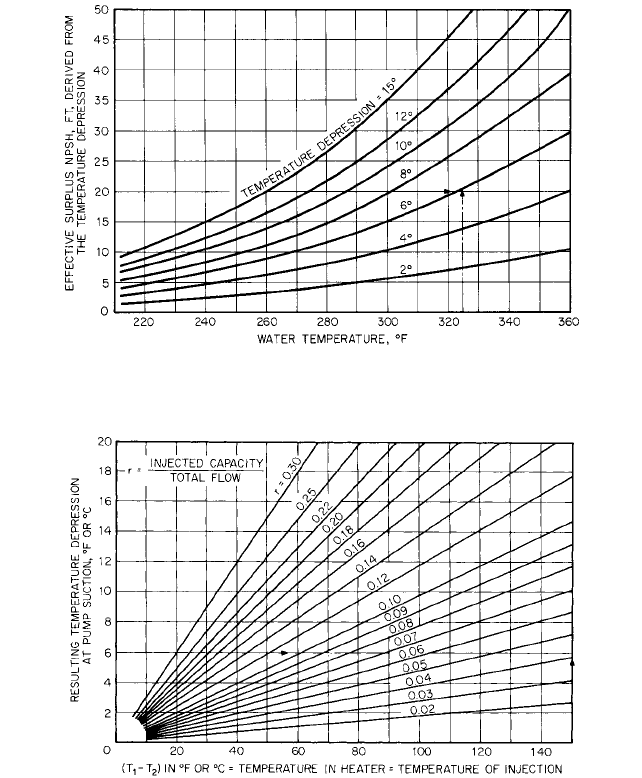
9.5 STEAM POWER PLANTS 9.83
FIGURE 10 Effect of subcooling on available NPSH at various initial water temperatures. [ºC = (ºF [min] 32)5/9;
1 ft = 0.3048 m]
FIGURE 11 Required amount of cold water injection for a given temperature depression
corrective action can be initiated automatically. This involves constant monitoring of the
suction pressure and of the vapor pressure of the feedwater at the pump suction. The dif-
ference between the two is then constantly compared with a pre-established minimum
NPSH. Any transient condition that causes the available NPSH to fall below this desired
minimum initiates corrective action, be it admission of cold condensate at the pump suc-
tion or admission of auxiliary steam to the direct-contact heater.
Another transient condition that will create a two-phase (steam-water mixture) flow
at the pump suction
—
and in the pump
—
may occur during a “hot restart.” When the
plant experiences a trip, the pump is secured and the pressure in the deaerator drops.
The temperature in the deaerator consequently drops within a relatively short period of
time. The feedwater temperature has dropped from perhaps 350°F (175°C) to 250°F
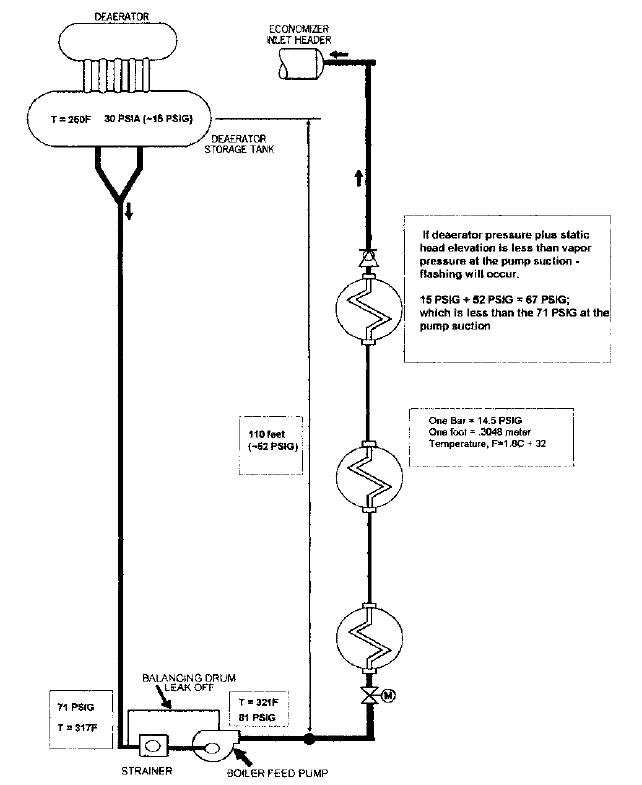
9.84 CHAPTER NINE
FIGURE 12 Feedwater system daigram, “hot restart” transient
(120°C). The pump and suction piping near the pump remain at a higher temperature
due to the mass of the metal (Figure 12). In a short time, the idle pump is switched on,
and a two-phase flow condition occurs at the pump suction. Potential failure mode effects
include suction cavitation, rotor upset and contact with stationary wear rings, and water
hammer.
BOOSTER PUMPS____________________________________________________
The increasing sizes of modern boiler-feed pumps coupled with the practice of operating
these pumps at speeds considerably higher than 3600 rpm have led to NPSH require-

9.5 STEAM POWER PLANTS 9.85
ments as high as 150 to 250 ft (46 to 76 m). In most cases, it is not practical to install the
direct-contact heaters from which the feed pumps take their suction high enough to meet
such requirements. In such cases, it has become the practice to use boiler-feed booster
pumps operating at lower speeds, such as 1750 rpm, to provide a greater available NPSH
to the boiler-feed pumps than can be made available from strictly static elevation differ-
ences. Such booster pumps are generally of the single-stage, double-suction design.
Discharge Pressure and Total Head The discharge pressure is the sum of the maxi-
mum boiler drum pressure and the frictional and control losses between the boiler-feed
pump and the boiler drum inlet. The required discharge pressure will generally vary from
115 to 125% of the boiler drum pressure. The net pressure to be generated by the boiler-
feed pump is the difference between the required discharge pressure and the available
suction pressure. This must be converted to a total head, using the formula
in USCS units
in SI units
Slope of the Head-Capacity Curve In the range of specific speeds normally encountered
in multistage centrifugal boiler-feed pumps, the rise of head from the point of best efficiency
to shutoff will vary from 10 to 25%. Furthermore, the shape of the head-capacity curve for
these pumps is such that the drop in head is very slow at low capacities and accelerates as
the capacity is increased.
If the pump is operated at constant speed, the difference in pressure between the pump
head-capacity curve and the system-head curve must be throttled by the feedwater regu-
lator. Thus the higher the rise of head toward shutoff, the more pressure must be throttled
off and, theoretically, wasted. Also, the higher the rise, the greater the pressure to which
the discharge piping and the closed heaters will be subjected. However, it is not advisable
to select too low a rise to shutoff because too flat a curve is not conducive to stable control;
a small change in pressure corresponds to a relatively great change in capacity, and a
design that gives a very low rise to shutoff may result in an unstable head-capacity curve,
difficult to use for parallel operation. When several boiler-feed pumps are to be operated
in parallel, they must have stable curves and equal shutoff heads. Otherwise, the total flow
will be divided unevenly and one of the pumps may actually be backed off the line after a
change in required capacity occurs at light flows.
As feedwater flows increased in the 650 to 1300 MW fossil central stations and new
construction of nuclear power plants occurred, the pump specific speed (N
S
) increased.
[Refer to Section 2.1.] Specific speeds of 1200 to 1500 for typical feedwater pumps
increased to 1600 to 2100. The performance curve characteristic for 1200 to 1500 N
S
pumps typically has a constantly rising curve slope. The performance characteristic for a
pump with a N
S
of 1600 to 2100 often will exhibit a depression (change to a very low, or
negative slope) at reduced flow rates (Figure 13).
NOTE: If a high specific-speed pump is operated at low loads and reduced flow rates, there
is risk of entering a performance curve region that will result in flow instability and surge.
High subsynchronous vibrations and possible vane pass energy is excited (Figure 14,
N
S
1700). This operating condition is potentially damaging to the boiler feed pump.
Attention to impeller and diffuser areas is critical to prevent this condition from occur-
ring. Underfiled impellers (see Subsection 2.3.1) and high area ratios between the impeller
and the diffuser or volute will tend to flatten the performance curve and can result in a
depressing effect on the slope of the performance curve.
Driver Power A boiler-feed pump will generally not operate at any capacity beyond the
design condition. In other words, a boiler-feed pump has a very definite maximum capac-
ity because it operates on a system-head curve made up of the boiler drum pressure plus
Total head, m
net pressure, bar 10.2
sp. gr.
Total head, ft
net pressure, lb>in
2
2.31
sp. gr.

9.86 CHAPTER NINE
FIGURE 13 Pump performance curve characteristic—specific speed versus stability
(Universal specific speed
s
= N
s
/2733 • N
q
(in rpm, m
3
/s, m) = N
s
/51.65)
FIGURE 14 Performance characteristic—28,000 hp boilder feed pump (N
s
1700)
(Universal specific speed
s
= N
s
/2733 • N
q
(in rpm, m
3
/s, m) = N
s
/51.65)
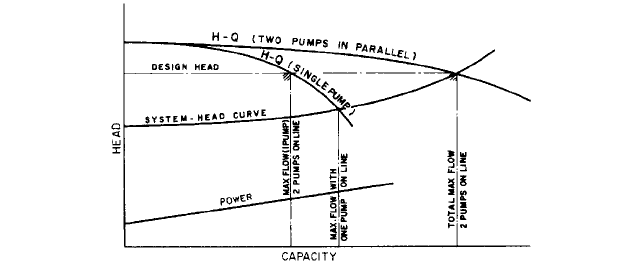
9.5 STEAM POWER PLANTS 9.87
FIGURE 15 Method of determining maximum pump power for two boiler-feed pumps operating in parallel
the frictional losses in the discharge. If, as it should be, the design capacity of the pump
is chosen as the maximum capacity that can be expected under emergency conditions,
there can be no further increase under any operating conditions since the pressure
requirement corresponding to an increased capacity would exceed the design pressure of
the pump. Even when the design pressure includes a safety margin, the boiler demand
does not exceed the design capacity, and the feedwater regulator will impart additional
artificial frictional losses to increase the required pressure up to the pressure available
at the pump.
When two pumps are operated in parallel, feeding a single boiler, the situation is some-
what different. If one of the pumps is taken off the line at part load, the remaining pump
could easily operate at capacities in excess of its design because its head-capacity curve
would intersect the system-head curve at a head lower than the design head (Figure 15).
In such a case, it is necessary to determine the pump capacity at the intersection point; the
power corresponding to this capacity will be the maximum expected. It is not always nec-
essary to select a driver that will not be overloaded at any point on the boiler-feed pump
operating curve. Although electric motors used on boiler-feed service generally have an
overload capacity of 15%, it is usually the practice to reserve this overload capacity as a
safety margin and to select a motor that will not be overloaded at the design capacity.
Exceptions occur in the case of very large motors. For instance, if the pump brake horse-
power is 3100, it is logical to apply a 3000-hp motor, which will be overloaded by about 3%
rather than a considerably more expensive 3500-hp motor. Because steam turbines are not
built in definite standard sizes but can be designed for any intermediate rating, they are
generally selected with about 5% excess power over the maximum expected pump power.
General Structural Features Boiler feed pumps designed for pressures of less than
2500 lb/in
2
(172 bar) are generally of the axially split casing type (Figure 16). Some spe-
cial axially split designs approach 4000 lb/in
2
(275 bar) maximum working pressure. Radi-
ally split segmental ring-type pumps (Figure 17) are utilized for pressures up to
approximately 3500 lb/in
2
(240 bar). Radially split, double-case barrel pumps (Figure 18)
are in feedwater services up to 6500 lb/in
2
(250 bar). The selection of materials for boiler
feed pump casings and internal parts is discussed in Section 5.1.
Nuclear Power Plants In oversimplified form, the nuclear energy steam power plant
differs from the conventional power plant only in that it uses a different fuel. Thus what
is called the secondary cycle (consisting of turbogenerator, condenser and auxiliaries, and
boiler-feed pumps) is not very different from its counterpart in the conventional steam
power plant. The main differences are a desire for even greater equipment reliability and
a preference for an absence or minimum of leakage to avoid any possibility of contamina-
tion with radioactive material. One other difference distinguishes most nuclear power

9.88 CHAPTER NINE
FIGURE 16 Axially split case multistage boiler feed pump, up to 3500 lb/in
2
(241 bar). (Flowserve Corporation)
FIGURE 17 Radially split, segmental ring boiler feed pump (Flowserve Corporation)
plants today from their fossil fuel counterparts: their operating steam pressures and tem-
peratures are much lower. Consequently, in most cases, reactor feed pumps are single-stage
pumps; a typical section is shown in Figure 19. The lower operating conditions result in
higher heat rates, and the flows
—
both of the feedwater and of the condenser circulation
—
are about one-third higher than for fossil fuel power plants of equal megawatt rating.
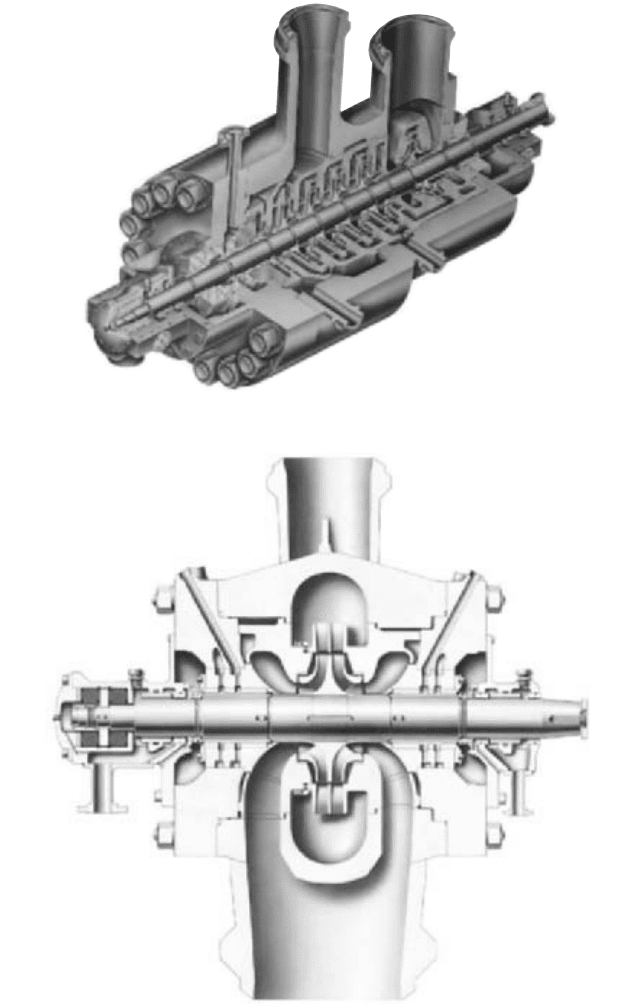
9.5 STEAM POWER PLANTS 9.89
FIGURE 18 Radially split, double-case, barrel boiler feed pump (Flowserve Corporation)
FIGURE 19 Single stage double suction reactor feed pump, 12,000 horsepower (8950 KW) (Flowserve
Corporation)
9.90 CHAPTER NINE
More detailed information on other nuclear power plant pumping services is given in
Subsection 9.14.1.
High-Speed, High-Pressure Boiler Feed Pumps As steam pressures rose to 3000
—
and even to 4500 lb/in
2
(200 to 310 bar)
—
the total head that was required to be developed
by the pump rose from around 4000 ft (1220 m) to as high as 7000 and 12,000 ft (2140
and 3660 m). The only means available of achieving these higher heads at 3600 rpm (2-
pole motor speed at 60 Hz) was to increase impeller diameter and the number of stages.
The pumps had to have longer and longer shafts to accommodate the larger number of
stages. This threatened to interfere with the long uninterrupted life between overhauls
to which steam power plant operators were beginning to become accustomed. The logical
solution was to reduce the shaft span by reducing the number of stages.
In the 1970s, stage pressures rose from around 800 ft/stage to 3000 ft/stage and higher.
Several single, 65,000 horsepower (48,500 kW) boiler feed pumps were constructed to sup-
port 1300 MW fossil plants (Figure 20). The higher head requirements were achieved by
increasing the speed of rotation instead of increasing impeller diameter or stage number.
As a result, boiler feed pumps in large central stations today generally operate at speeds
from 5000 to 9000 rpm.
Boiler-Feed Pump Drives The majority of boiler-feed pumps in small and medium-size
steam plants are driven by electric motors. It was the practice to install steam-turbine
driven standby pumps as a protection against the interruption of electric power, but this
practice has disappeared in central steam stations.
Central stations have trended away from electric motor drives, including those
equipped with hydraulic couplings, fluid, and variable frequency drives, to steam turbines
for units in excess of 200 MW because
1. The use of an independent steam turbine increases plant capability by eliminating
the auxiliary power required for boiler feeding.
2. Proper utilization of the exhaust steam in the feedwater heaters can improve cycle
efficiency.
3. In many cases, the elimination of the boiler-feed pump motors may permit a reduction
in the station auxiliary voltage.
4. Driver speed can be matched ideally to the pump optimum speed.
5. A steam turbine provides variable-speed operation and better flow compliance to
varying plant load and flow demands without an additional component, such as a
hydraulic coupling.
Many combined cycle plants are constructed utilizing motor-driven boiler feed pumps
to facilitate flexibility in start-up and varying load demands.
Application of variable frequency drive (VFD) motors continues as equipment costs drop.
The VFD technology provides variable motor speeds by controlling the frequency input.
Operation of Boiler-Feed Pumps at Reduced Flows Operation of centrifugal pumps
at shutoff or even at certain reduced flows can lead to very undesirable results. This sub-
ject is covered in detail in Subsections 2.3.1 to 2.3.4, Section 8.1, and Chapter 12, where
methods for calculating minimum permissible flows and means for providing the neces-
sary protection against operation below these flows are discussed.
Recent experiences have clearly defined the need to understand hydraulic instability,
cavitation, and separation as they relate to off-design flow operation.
As deregulation and economic constraints dictate plant load cycling to match elec-
tricity demands and operating costs, the large central station boiler feed pumps experi-
ence significantly low operating flow. The low flow operation, high impeller suction
specific speed, and high inlet tip speeds result in mismatched flow angles, backflow
recirculation, and severe suction impeller inlet cavitation damage. This low flow
hydraulic instability will also result in damage to pump volute cutwaters and diffuser
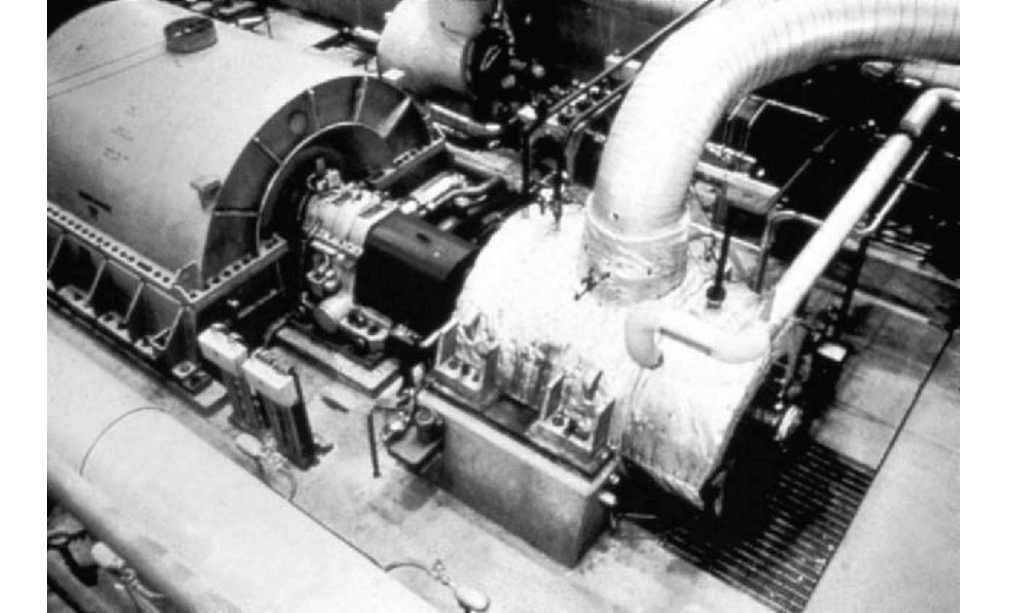
9.5 STEAM POWER PLANTS 9.91
FIGURE 20 Installation of a single 65,000 horsepower (48,500 kW) boiler pump feed (Flowserve Corporation)
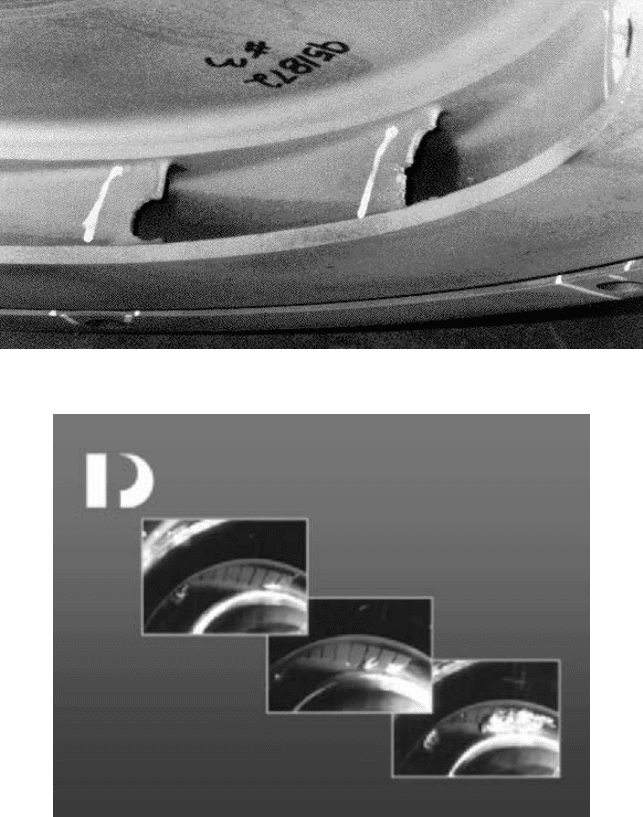
9.92 CHAPTER NINE
FIGURE 21 Diffuser inlet vane erosion damage (Flowserve Corporation)
FIGURE 22 Unsteady vapor cavity behavior, feed pump at low flow (Flowserve Corporation)
vanes (Figure 21). Suction impellers where the suction specific speed exceeds 10,000
and eyebore inlet tip speeds exceed 200 ft/sec. are highly susceptible to this low flow
instability and component damage. The series of photos in Figure 22 show a condition
typical for many high-energy pumps operating at flows below design levels. They
demonstrate how serious low-flow instability can be when it is coupled with two-phase
flow activity.
The severity of cavitation erosion is highly dependent on the inlet tip speed of the suc-
tion stage impeller, the NPSHA, and the thermodynamic properties of the fluid being
pumped. The erosion seen in Figure 23 was caused by the collapse of discrete cavitation
